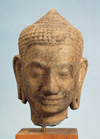 |
  |
|

|
|
| |
Ong
Keng Sen |
| |
Ong Keng Sen
is a performance director. He was born in Singapore. His works have
been presented in Asia, Australia, Europe, and the United States.
Ong holds a number of foundation fellowships including the Japan
Foundation, British Council, Asian Cultural Council, and is also
a Fulbright Scholar. He has also lectured extensively in Europe,
Australia, and Asia. In 2000 Ong directed his first opera, The
Silver River, by David Henry Hwang and Bright Sheng for
the Spoleto Festival. It will have its New York City premiere at
the Lincoln Centre Summer Festival in 2002. His latest work, which
premiered at Yale University in June 2001 for the International
Festival of Arts and Ideas, is a documentary performance with a
68-year-old Cambodian dancer who survived the genocide during the
Pol Pot years, The Continuum: Beyond The Killing Fields
Selected
Objects
|
|
 |
|
 |
| |
 |
Court
Lady
North China
Tang period, 8th century
Earthenware with multicolored lead glazes and traces of pigment (sancai
ware)
H. 14 1/8 in. (35.9 cm); 1979.113
|
I
am often intrigued by representations of artists or people expressing themselves
in dance and music. These representations are often a valuable record of
the way instruments were played, the postures and the context in which they
were played. In the case of this court lady, I was also incredibly drawn
to her hair. The styles of ornamentation and decoration were often fantastical,
especially in the Chinese court and this is a great example of that.
|
| |
 |
Head
of Buddha
Cambodia
Angkor period, Bayon style, 12th-13th century
Sandstone
H. 13 in. (33.0 cm); 1979.71
|
I
like it when I can see the face of the man on the street who just sold me
a bunch of rambutans in the face of a Buddha. The globular contour
of the eye under the skin, the luxurious ear lobes, the full smile, and
the large nose combine to suggest a graciousness, an abundance, and an openness.
|
| |
 |
Kneeling
Woman
Cambodia
Angkor period, late 11th-early 12th century
Copper alloy
H. 18 3/4 in. (47.6 cm); 1979.69
|
The
angularity of this figure is attractive to me. The human body becomes articulated
as lines, shapes, form, and architecture. The hard lines imprint into my
imagination and I close my eyes to erase her. But the negative space between
her hands and above her head continues to haunt me.
|
| |

|
Female Figure
Cambodia
Angkor period, Baphuon style, early 11th century
Sandstone
H. 38 in. (96.5 cm); 1979.65
|
The
simple elegance of proportion and balance. I am drawn in particular to her
belly and the suggestion beneath the translucent skinlike sarong. But her feet ...
|
| |

|
Dish
China, Jiangxi Province
Ming period, early 15th century (probably Yongle
era, 1403-1424)
Porcelain with impressed and incised design under glaze (Jingdezhen ware)
H. 4 in. (10.2 cm), D. 8 1/4 in. (21 cm); 1979.158
|
As
we are asked to select our favorite pieces based on photographs, I am drawn
to this white dish for its apparent simplicity. Simplicity is hard to achieve
in expression and it takes a secure person to strive for simplicity. Looking
at the photograph, I was drawn to the fact that it could be an everyday
object that I use in my kitchen. The distance between art and daily life/design
is not that much. Time immortalizes an object; often the everyday becomes
reconsidered as art (it could be an everyday object of an emperor and then
it takes on a different significance!) The catalogue tells me that there
is under the glaze a decoration of two dragons. This makes it, of course,
more than its apparent simplicity. I am also told that this is an example
of eggshell porcelain which is much prized as it is very difficult to fire
successfully. I am looking forward to seeing the thinness myself at the
exhibition.
|
| |
 |
Female
Figure
Japan, Aomori Prefecture
Final Jomon period (1000-300 B.C.E.)
Earthenware with traces of pigment (Kamegaoka type)
H. 9 7/8 in. (25.1 cm); 1979.198
|
| I
chose this figure as it is so different from the Japanese art that we see
today. As we encounter cultures, it is often easy to say "that's just so
Japanese." This figure completely breaks that cliché of stark austerity
and highly stylized minimalism which has come to characterize one type of
Japanese aesthetics. It is also very different from the urban pop that contemporary
Asian youth identify with today. In a sense, an exhibition like this often
makes the visitor reflect on the process of time; how representation often
narrows into a stereotype and we spend all our time trying to undo the cliche
or to counter the established norm. Here is the living proof of the multiplicity
of cultural expressions in the continuum of time. The perverse beauty of
this figure with its superb thick neck is intriguing as it may suggest a
standard of beauty and aesthetics aspired toward. |
|
|
|





